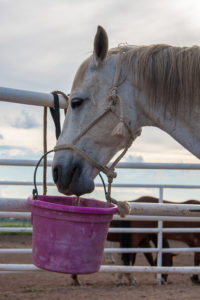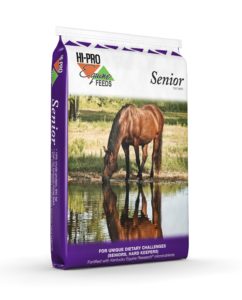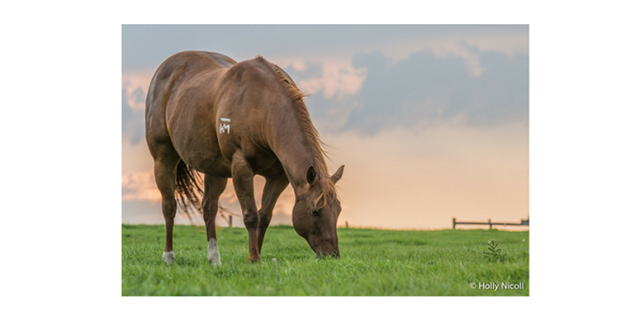By Matt McMillan, Ph.D., Equine Nutritionist, Hi-Pro Feeds
The senior horse has become more prevalent in modern times due to the change in workload, and activity of horses in general compared to what was required of the horse many years ago. Before the gasoline engine, horses were used for transportation and farming purposes. They were truly, under most circumstances considered a ‘beast of burden’. Because of the strenuous workload, very few horses lived to be senior age. If a horse had not been started too young or overworked, had good health care, and proper nutrition throughout its life, it might have lived to be what was considered extremely old to ~25 years of age.
Nowadays, the primary use of the horse has changed to being used for general pleasure including horse sport competition. Due to the change in workload and use, the care and quality of life of the horse has significantly increased. Older horses continue to thrive and compete upward into their late teens and twenties. It has been reported that the average life span of the modern horse is ~24 years of age. However, many horses are living well past that and even continuing to be actively ridden as well as being utilized for reproductive purposes.
When considering how horses mature, it is interesting to note that they advance quite rapidly when compared to humans. At 6 months of age the horse can be compared to a 6-year-old child. At 12 months of age, the horse is equivalent to the 12-year-old pre-teen. Further, at 2 years, the horse is equivalent to the 18-year-old teenager. As the horse ages, every 1 year is equivalent to 3 years of a human life. Therefore, a 20-year-old horse is equivalent to a 60-year-old person. As the horse approaches 20 years of age, noticeable outward signs of aging generally begin to occur. Some of these signs include: graying of the hair, particularly around the eyes, temples, and nostrils; increased sinking of the hollows above the eyes, greater swaying of the back, increased prominence of the backbone, and sometimes the drooping of the lower lip. Other factors that occur due to aging include decreased nutrient absorption in the gut, and disease.
Nutrient absorption in the horse decreases with age. As the horse gets older, the effectiveness of the intestinal lining decreases, and makes it difficult for nutrients to pass through the intestinal wall and into the bloodstream. Further, the production of enzymes begins to decrease particularly the enzymes necessary to break down starch. This could be a concern especially if the senior horse’s diet is high in starch. If the horse cannot breakdown starch in the small intestine, it may enter in to the hindgut causing the hindgut to become acidic creating a situation that may lead to colic or founder. Another factor affecting the availability of nutrients is particle size. If the horse’s teeth fail to properly reduce particle size, then the digestive enzymes and microbes will not be able to effectively digest the feedstuff. This in turn will contribute to decreased digestive efficiency.
Further factors reducing nutrient absorption are internal parasites. Internal parasites can create significant damage in the intestine, which in turn can greatly reduce nutrient absorption. The presence of the parasites creates a multi-level problem. Over time, especially without a proper de-worming program, the parasites create scar tissue where they have attached to the intestinal lining and therefore decrease the surface area in the intestine where absorption can take place. The parasites also compete with the horse for nutrients. One nutrient that is greatly affected in the senior horse upon chronic parasite damage is protein. Muscle tissue degeneration is a common occurrence in the senior horse due to the lack of necessary protein that can be utilized from the diet. If the body does not receive enough protein in the diet, it will then begin to breakdown its own muscle tissue to provide for necessary protein needs.
Disease becomes more prevalent as the horse ages. Tumors are more common in the senior horse. Dermal melanomas occur in nearly 80% of all gray horses over the age of 15. Thyroid adenomas were reported in one study to be present in ~37% of horses 18 years or older, and pituitary adenomas have also been reported as being common in the senior horse. Pituitary adenomas can be a concern nutritionally due to the location on the pituitary gland. These tumors reduce normal hormone production causing a condition generally known as Cushing’s disease. This disease can cause insulin resistance, poor hair coat, muscle degeneration, and possible founder. Finally, additional problems found in senior horses include arthritis, liver and kidney disease and/or failure, respiratory disease, as well as other potential problems.
Care for the senior horse is vital to their longevity and quality of life. Many good feeding and management practices can be implemented long before the horse enters in to its senior years to proactively stave off the potential negative effects associated with aging.
Good quality and quantity of forage is always necessary in the horse’s diet for proper nutrition maintenance. As horses age, hay may become a challenge to chew due to dental problems. Alfa-Pro™ from Hi-Pro Feeds may be a good hay alternative due to its high quality forage value. The product is easily broken down upon the horse taking it into its mouth, and there is less dust when compared to hay. Alfa-Pro can also be soaked if necessary for horses that may not have any teeth. Soaked Alfa-Pro can be completely broken down in about 3 minutes upon the inclusion of water. It provides the necessary vitamins and minerals, as well as pre- and pro-biotics to aid in nutrient digestion, and vitamin E to provide added antioxidant synthesis.
 Senior horses will generally need an additional feed source to provide the necessary energy in the diet. However, it is important that the energy is provided properly so that starch does not overload the system and create problems. Hi-Pro Feeds Senior Textured Horse Feed provides a low starch, high fat diet that provides energy through quality fat sources including flax, stabilized rice bran, canola, and soy.
Senior horses will generally need an additional feed source to provide the necessary energy in the diet. However, it is important that the energy is provided properly so that starch does not overload the system and create problems. Hi-Pro Feeds Senior Textured Horse Feed provides a low starch, high fat diet that provides energy through quality fat sources including flax, stabilized rice bran, canola, and soy.
It’s best to provide energy through fat sources rather than starch due to the senior horse’s reduced ability to synthesize the enzymes necessary to breakdown starch in the small intestine. Further, it is important to provide energy through fat due to the potential presence of Cushing’s disease or any other insulin resistant related disease. The senior horse needs to receive adequate protein in the diet so that muscle tissue degeneration does not occur. The Hi-Pro Feeds Senior Textured Horse Feed provides a 14% crude protein value through quality protein sources such as canola, soy, and alfalfa. It is easily broken down upon consumption, and also provides feed additives that aid in digestion, immune response, reduced inflammation, and overall health. For more information on Hi-Pro Horse Feeds visit our products page.

